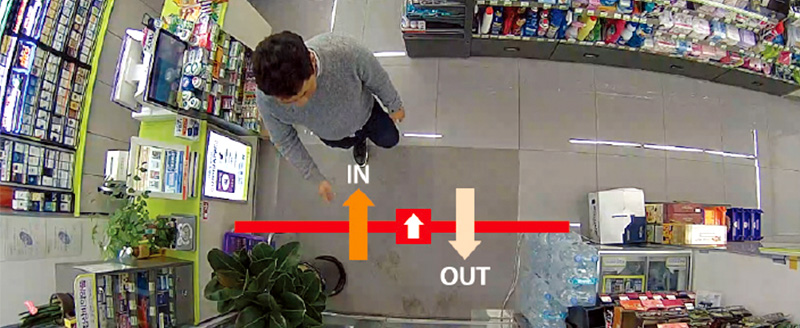Seeing Smarter: AI-Based Surveillance Cameras Boost Security and Work Efficiency

AI-enabled surveillance cameras can track individual objects and each of their attributes even in extremely busy locations
The never-ending rush of urban living translates into constant waves of people and vehicles surging through city streets at all hours. It is an exhilarating study in motion. As urban populations continue growing, this activity will only become more intense and complex.
How to make sense of it all?
The answer lies in artificial intelligence (AI).
Keeping track of all the action

AI-enabled surveillance cameras can distinguish between many different objects and attributes
Many city streets are covered by arrays of surveillance cameras. These monitor traffic patterns, scan for accidents, and help keep the streets safe overall.
However, as surveillance camera networks grow along with the cities they cover, they begin taking in too much information for human operators to handle. Now, AI algorithms built into surveillance camera operating systems are allowing for more effective city management.
At the most basic level, an AI-enabled surveillance camera will use image recognition to distinguish what it sees into broad categories such as “Person,” “Face,” “Vehicle,” and “License Plate.”

Hanwha Techwin Wisenet P series AI cameras utilize an AI algorithm to analyze the attributes of the subjects
Diving a bit deeper, a camera’s AI algorithms are quickly and accurately able to identify the different attributes of what the camera sees. For example, Hanwha Techwin’s latest Wisenet P series AI cameras utilize an AI algorithm to see a person and immediately detect the color of her clothing. These cameras are also intelligent enough to distinguish whether she is wearing glasses or holding a bag. These attributes are then saved as metadata alongside the footage.
The efficiency of this image-recognition capability and storage of metadata is apparent when footage needs to be examined. Rather than manually parsing hours of footage to try and spot a person in a crowd, human operators may input the attributes they are looking for and time frame they are interested in. Using video management software such as Wisenet SSM, the security system will then filter through the metadata from the cameras to find the results that best match operators’ search queries more quickly.
Helping with store management, not just security
The benefits of AI-enabled surveillance cameras can also be felt within retail spaces.
The venerable in-store security camera has long-been used to catch and deter theft. Now, store operators may combine AI-enabled surveillance cameras with solution like Hanwha Techwin’s Wisenet Retail Insight to gain a granular look at what is happening within their stores.
Similar to smart city management, AI-enabled surveillance cameras use attribution identification to help operators track customer demographics. The cameras’ AI algorithms are trained to identify people’s attributes as accurately as people by analyzing millions of photos. These trained algorithms can show store operators when different gender and age groups frequent an establishment and which products these groups are most drawn to. This gathered intelligence can then be used to make informed decisions and adjust their stores to best match shopping trends and maximize sales.

Wisenet Retail Insight analyzes what AI-enabled surveillance cameras see and delivers valuable business intelligence

This can be done in a number of ways. A clothing retailer may position surveillance cameras at store entrances to track how many customers pass through during operating hours. This information can be analyzed in real-time to inform operators of when the store is attracting the optimum number of customers. It can also help determine when there are too many or too few customers and why those situations are occurring.

Within the clothing store, the camera-recorded footage can be used to create customer heatmaps to show which departments and racks are the most frequented. Diving deeper, the heatmaps can even identify which demographics prefer certain products and if a sale is more likely if a rack is placed in a specific location. Store operators may use this information to strategize store layouts so that merchandise may best appeal to their target consumers.

AI-enabled surveillance cameras can also assist store managers efficiently station employees. The cameras and management software will help managers identify which sections require the most assistance. This allows them to reposition workers and make sure customers are adequately serviced during their shopping experience.
Hanwha Techwin is currently developing a new chipset that will give its Wisenet cameras deep learning capabilities.
Already, the insights made possible by AI are transforming how video surveillance systems operate. Whether in a store or on the street, AI-enabled surveillance cameras watch over busy environments and quickly identify incidents requiring human intervention, speeding up response times. With its cutting-edge technology and focus on R&D, Hanwha Techwin will continue ushering in future refinements in AI-enabled surveillance cameras to make cities safer and improve work operations.
Hanwha Vision
Hanwha Vision (formerly Hanwha Techwin) has been leading the global video surveillance industry with world-class optical design, image processing and cybersecurity technologies for more than 30 years. As it broadens its business to become a global vision solution provider, Hanwha Vision will deliver more valuable and meaningful insights to customers by collecting key information and providing big data analytics utilizing AI and cloud technologies.
For more information, visit: HanwhaVision.com/
Get the latest news about Hanwha, right in your inbox.
Fields marked with * are mandatory.
- Non-employee
- Employee




